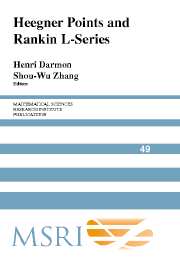Book contents
- Frontmatter
- Contents
- Preface
- Heegner Points: The Beginnings
- Correspondence
- The Gauss Class Number Problem for Imaginary Quadratic Fields
- Heegner Points and Representation Theory
- Gross–Zagier Revisited
- Special Value Formulae for Rankin L-Functions
- Gross-Zagier Formula for GL(2), II
- Special Cycles and Derivatives of Eisenstein Series
- Faltings' Height and the Derivatives of Eisenstein Series
- Elliptic Curves and Analogies Between Number Fields and Function Fields
- Heegner Points and Elliptic Curves of Large Rank over Function Fields
- Periods and Points Attached to Quadratic Algebras
Special Value Formulae for Rankin L-Functions
Published online by Cambridge University Press: 06 July 2010
- Frontmatter
- Contents
- Preface
- Heegner Points: The Beginnings
- Correspondence
- The Gauss Class Number Problem for Imaginary Quadratic Fields
- Heegner Points and Representation Theory
- Gross–Zagier Revisited
- Special Value Formulae for Rankin L-Functions
- Gross-Zagier Formula for GL(2), II
- Special Cycles and Derivatives of Eisenstein Series
- Faltings' Height and the Derivatives of Eisenstein Series
- Elliptic Curves and Analogies Between Number Fields and Function Fields
- Heegner Points and Elliptic Curves of Large Rank over Function Fields
- Periods and Points Attached to Quadratic Algebras
Summary
Introduction
Let F denote a totally real number field, and let K/F denote a totally imaginary quadratic extension. We fix an automorphic cuspidal representation π of GL2(F), and a finite order Hecke character χ of K. Thus χ is a representation of GL1(K).
Under certain hypotheses, it is known that the central critical value L(π⊗χ, ½) is algebraic up to a known transcendental factor. Explicit formulae for this value have been given by a number of authors, notably Gross, Waldspurger, and Zhang. Essentially, the work of Gross and Zhang shows that this value is given by the height of a certain CM divisor on a suitable space, while the work of Waldspurger gives a criterion for nonvanishing of this value in terms of a certain linear functional arising from representation theory, and a formula in terms of torus integrals on a quaternion algebra. Our goal in this article is to explain the connections between these works, and to provide a bridge between the general representation-theoretic framework described by Gross (see his article [Gro] in this volume) and the theorems of Zhang [Zha01a] and Waldspurger [Wal85].
We want to point out that the formula we will discuss has numerous applications to arithmetic and Iwasawa theory (see [BD96] and its various sequels). We will therefore attempt to formulate the representation-theoretic results in terms that are familiar to number theorists. We will not however discuss any arithmetic applications directly—the reader will find some of these applications elsewhere in this volume.
- Type
- Chapter
- Information
- Heegner Points and Rankin L-Series , pp. 165 - 190Publisher: Cambridge University PressPrint publication year: 2004
- 3
- Cited by



